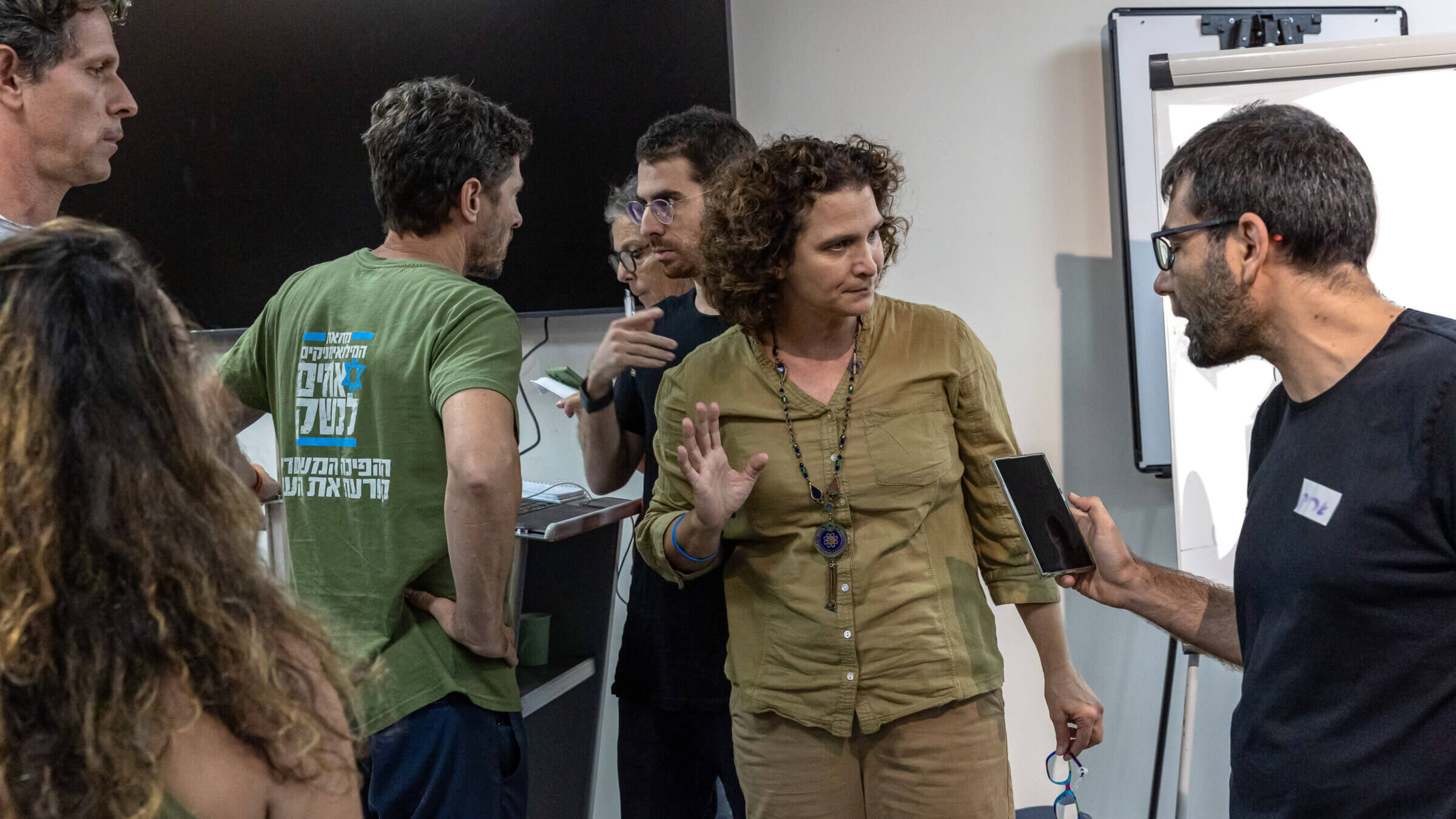‘I found a hostage!’: Inside the Tel Aviv war room where civilians locate the kidnapped
Over 1,500 Israeli tech experts volunteer around the clock to find kidnapped or missing civilians

Professor Karine Nahon, 50, directs an ad-hoc war room in Tel Aviv dedicated to finding those kidnapped by Hamas. Photo by Laura Ben-David for the Forward
TEL AVIV — “I found a hostage!”
A man in a T-shirt ran to tell Professor Karine Nahon the news. There was already a frenzy of activity in the makeshift war room, and upon this revelation, half a dozen volunteers rushed to capitalize on the information.
Inside the transformed Tel Aviv Expo Center, 1,500 Israeli tech experts are working around the clock to locate the estimated 100-plus soldiers and civilians who have been kidnapped by Hamas and other terrorist groups. This is not a government or military operation, though they are sharing any intelligence they collect with both the army and the police.
This war room is run entirely by civilians — many of them the very same people who have been organizing the mass pro-democracy protests in Israel’s streets for 40 weeks. And minutes after I gained access to observe their room on Wednesday afternoon, they somehow managed to locate a hostage.
The reconnaissance efforts are being led by Nahon, who during regular times leads the data, government and democracy program at Reichman University in Herzliya. She and the others on her ad-hoc team, which now fills three auditorium-sized rooms of the convention center, are using infrastructure developed to coordinate protests against the government’s judicial overhaul.
“We know a lot of things that the government doesn’t know,” she told me.

Nahon sprang into action shortly after Hamas’s unprecedented assault on Israel Saturday morning. By Sunday, she had assembled a team working out of the Mixer, a coworking space within the Tel Aviv Expo Center. The space had previously housed a group working for Brothers in Arms, a movement of reservists who oppose Netanyahu’s judicial overhaul. Now, Brothers in Arms and other protest organizations have totally shifted their focus to war relief efforts.
By Wednesday, out of the fear of bombs, Nahon’s group had moved into three rooms of the expo center itself. The sprawling campus has been transformed overnight into the headquarters of civilian relief efforts in the city.
Just 500 yards away, in a parking lot, volunteers pack boxes of donated clothing, toys, baby supplies and books, which are then hurried away to communities in the north and south. There was no traffic in Tel Aviv, except for the line of cars snaking through the entrance to the Expo Center. Alongside one building of the sprawling complex stood rows of plastic chairs — for the many families who are suddenly sitting shiva.
The makeshift war room, which is only accessible to those working on the project, is filled with a mix of frenetic energy and intense focus. Many of the volunteers are founders or leaders of Israel’s vaunted high-tech sector of startups, people from both religious and secular backgrounds. Most are in shorts and T-shirts — some bearing the slogans of the months-long democracy movement — poring over their laptops. Others flit back and forth, running to convey urgent information between the researchers and those running the operation.
Using artificial intelligence and other cutting-edge tools, they analyze videos and photos posted on social and traditional media, trying to mine clues that can be used to identify particular hostages.
Archeologists have analyzed and mapped underground areas that could potentially serve as hiding spots for survivors — and the group has deployed rescue missions to see if people are hiding in those areas. They said they have located some of those who are missing, though would not share details.
Word spreads quickly in Israel: People with missing relatives have started showing up here to make inquiries.
That’s what Amit Farbman, a 50-year-old director of a boutique film production studio, told me. Since yesterday, he has been tapped as the unofficial guide to the war room for the few journalists allowed in. He cautioned me and the photographer I’m working with, Laura Ben-David, to blur out any screens in our photos, for fear the wrong people could exploit the sensitive information contained on them.
Farbman said he was in a “super combat unit in the army,” and also heavily involved in the protest movement. Though he lives in Ramat HaSharon, a 20-minute drive from North Tel Aviv on a good day, he now plans to spend most of his waking hours here.
“My wife asked me not to go to the south,” he told me. “It was tough for me not to go there. So yesterday, I came here.”
When volunteers show up at the center, they are asked about their tech skills — and whether they have first-degree relatives believed to have been abducted. If so, it’s a no-go: “I need guys with a strong stomach,” one team leader shared at a morning briefing. Just thinking of the horrifying videos and photographs, Farbman said, causes him to shake.
But there are missing people to be found, and people eager to find them. On Wednesday afternoon, Nahon stood on a raised platform, simultaneously working on a laptop and giving and receiving updates from half a dozen others.
As for how many of the missing the group has located so far, Nahon demurred.
“Let’s talk in two days,” she said.
Correction: An earlier version of this article gave the incorrect location for Reichman University. It is in Herzliya, not Jerusalem.
A message from our Publisher & CEO Rachel Fishman Feddersen

I hope you appreciated this article. Before you go, I’d like to ask you to please support the Forward’s award-winning, nonprofit journalism so that we can be prepared for whatever news 2025 brings.
At a time when other newsrooms are closing or cutting back, the Forward has removed its paywall and invested additional resources to report on the ground from Israel and around the U.S. on the impact of the war, rising antisemitism and polarized discourse.
Readers like you make it all possible. Support our work by becoming a Forward Member and connect with our journalism and your community.
— Rachel Fishman Feddersen, Publisher and CEO




























